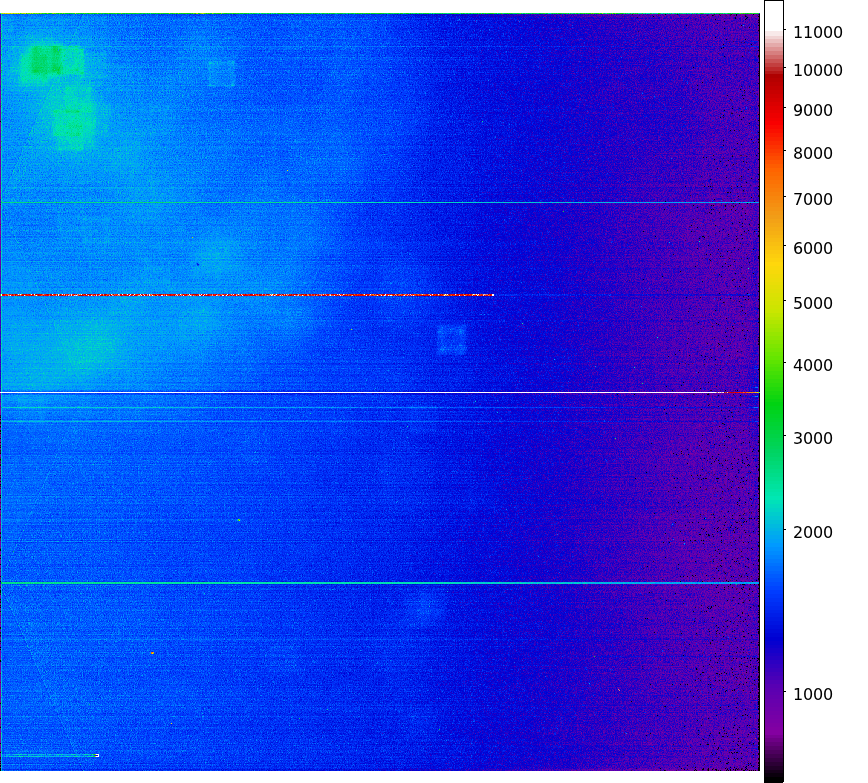ACIS
ACIS DOSE Registered-Photon-Map
The steps we took to compute the dose map are;
- Level 1 Event files for a specified month are obtained from archive.
- Image data including I2, I3, S2, S3 CCDs are extracted from all event files.
- All the extracted image data were merged to create a month long exposure map for the month.
- The exposure map is opened with ds9, and check a distribution of count rates against energy. From this, estimate the upper threshold value. Any events beyond this upper threshold are assumed erroneous events such as bad pixels.
- Using this upper threshold, the data is filtered, and create a cleaned exposure map for the month.
- The exposure map from each month from the Sep 1999 is added up to create a cumulative exposure map for each month.
- Using fimgstatistic, we compute count rate statistics for each CCDs.
- For observations with high data drop rates (e.g., Crab nebula, Cas A), we corrected the observations by adding events.
-
Note: Counts and RMS's of Cumulative maps are lower than the previous months.
This is because we excluded extreme outliers.
Please check more detail plots at Telemetered Photon Dose Trend page.
Statistics: # IMAGE NPIX MEAN RMS MIN MAX ACIS_apr12 6004901 6.653 9.408 0.0 338 I2 node 0 262654 5.968529 2.683777 0.0 46.0 I2 node 1 262654 6.288074 2.903605 0.0 170.0 I2 node 2 262654 6.094498 2.755685 0.0 45.0 I2 node 3 262654 6.268338 3.006703 0.0 40.0 I3 node 0 262654 6.598362 2.987026 0.0 37.0 I3 node 1 262654 6.889385 6.149359 0.0 142.0 I3 node 2 262654 6.233553 2.765599 0.0 40.0 I3 node 3 262654 6.059299 2.765950 0.0 95.0 S2 node 0 262654 8.089269 3.290458 0.0 255.0 S2 node 1 262654 8.422782 3.847329 0.0 64.0 S2 node 2 262654 8.589844 3.634027 0.0 330.0 S2 node 3 262654 8.254886 3.235345 0.0 384.0 S3 node 0 262654 15.912148 16.719288 0.0 220.0 S3 node 1 262654 15.273677 12.069511 0.0 129.0 S3 node 2 262654 11.889836 3.613127 0.0 42.0 S3 node 3 262654 10.836037 3.425545 0.0 33.0
Statistics: IMAGE NPIX MEAN RMS MIN MAX ACIS_total 6004901 1592.76 2130.34 0.0 95731 I2 node 0 262654 1320.084621 255.327930 0.0 6748.0 I2 node 1 262654 1394.003926 343.893950 0.0 28452.0 I2 node 2 262654 1427.994068 308.575427 0.0 8936.0 I2 node 3 262654 1423.977163 363.608271 0.0 27717.0 I3 node 0 262654 1491.089251 363.172367 0.0 6550.0 I3 node 1 262654 1565.222835 1183.543147 0.0 30411.0 I3 node 2 262654 1361.677347 247.849850 0.0 6527.0 I3 node 3 262654 1346.715416 263.408551 0.0 23948.0 S2 node 0 262654 1905.105921 268.449859 991.0 20822.0 S2 node 1 262654 2025.934252 438.024003 1024.0 11187.0 S2 node 2 262654 2247.344796 424.970147 1331.0 16285.0 S2 node 3 262654 2177.175795 314.314794 1271.0 34762.0 S3 node 0 262654 3318.096293 1658.917943 1381.0 13086.0 S3 node 1 262654 4493.330548 1963.959126 0.0 13591.0 S3 node 2 262654 3407.779795 909.857601 1304.0 8516.0 S3 node 3 262654 2631.184080 418.804795 1476.0 9517.0
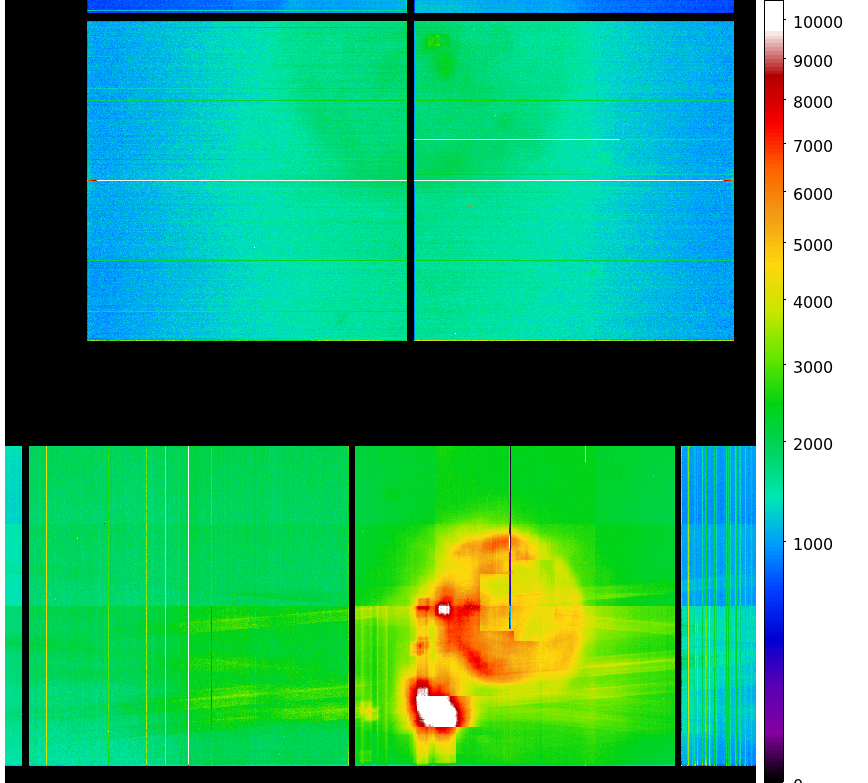
|

|

|

|
| Jan 2012 | Oct 2011 | Jul 2011 | Apr 2011 |
|---|
The Mean Detrended CTI
We report CTIs with a refined data definition. CTIs were computed for the temperature dependency corrected data. Please see CTI page for detailed explanation. CTI's are computed for Mn K alpha, and defined as slope/intercept x10^4 of row # vs ADU. Data file: here


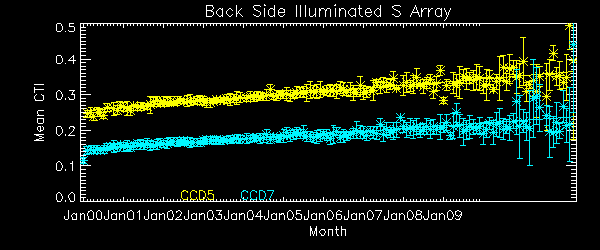
Focal Plane Temperature
Apr 2012 Focal Temperature
| The Mean (max) FPT: | |
|---|---|
| -109.86 | +/- 6.10 C |
| Mean Width: | |
| 0.58 | +/- 0.54 days |
Averaged Focal Plane Temperature
We are using 10 period moving averages to show trends of peak temperatures and peak widths. Note, the gaps in the width plot are due to missing/corrupted data.
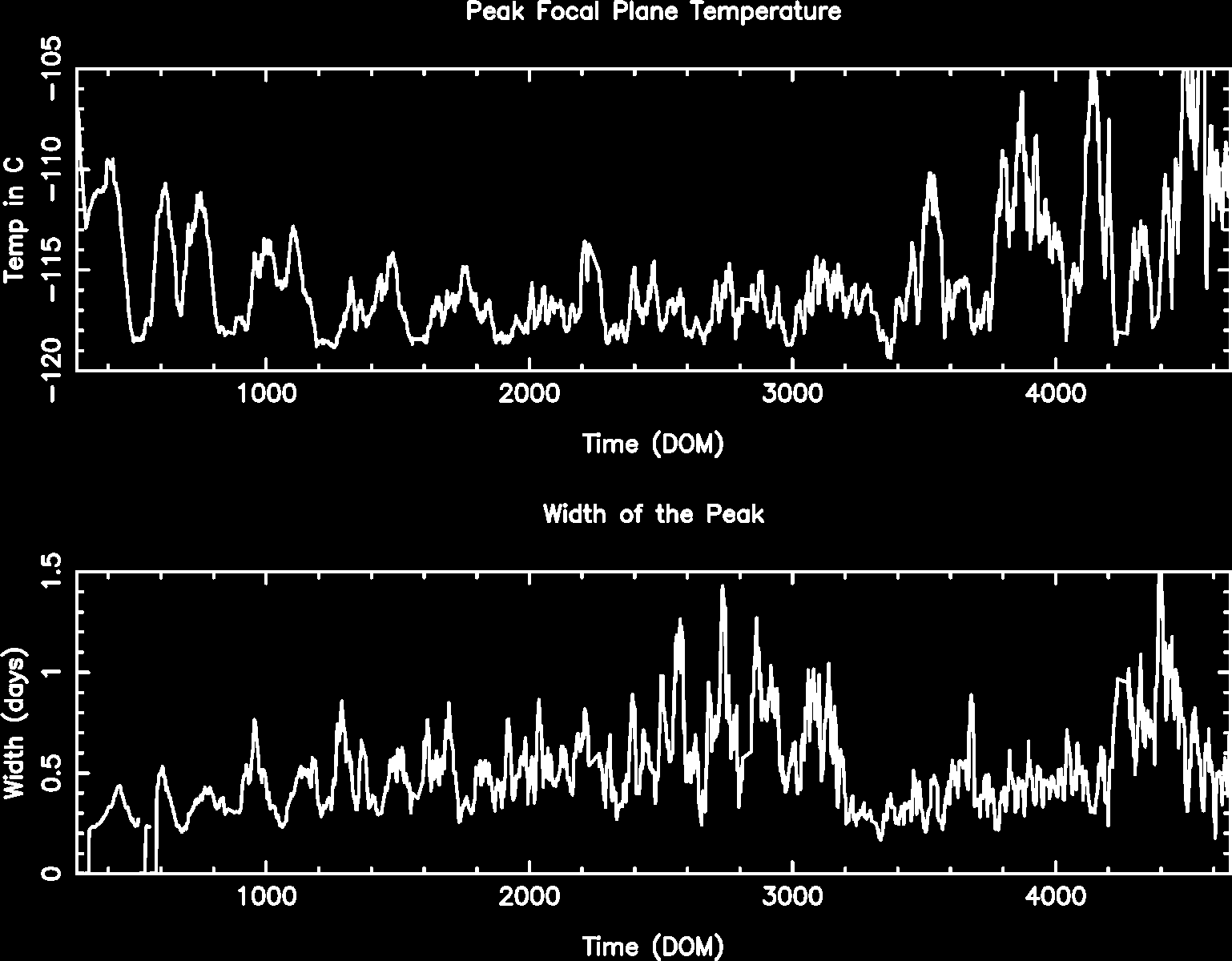
Focal Plane Temperature, Sun Angle and Altitude
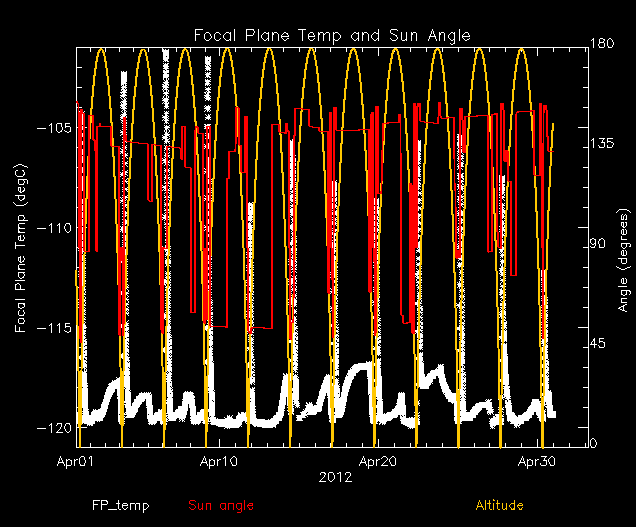
Bad Pixels
The plots below were generated with a new warm pixel finding script. Please see Acis Bad Pixel Page for details.
Front Side CCDs

Back Side CCD (CCD5)

Science Instrument Background Rates
| Name | Low (keV) | High(KeV) | Description |
|---|---|---|---|
| SSoft | 0.00 | 0.50 | Super soft photons |
| Soft | 0.50 | 1.00 | Soft photons |
| Med | 1.00 | 3.00 | Moderate energy photons |
| Hard | 3.00 | 5.00 | Hard Photons |
| Harder | 5.00 | 10.00 | Very Hard photons |
| Hardest | 10.00 | Beyond 10 keV |


HRC
DOSE of Central 4K Pore-Pairs
Please refer to Maximum Dose Trends for more details.
IMAGE NPIX MEAN STDDEV MIN MAX
HRCI_04_2012.fits 16777216 0.104 0.3414 0.0 10.0
IMAGE NPIX MEAN STDDEV MIN MAX
HRCI_08_1999_04_2012.fits 16777216 3.860 4.706 0.0 292.0
IMAGE NPIX MEAN STDDEV MIN MAX
HRCS_04_2012.fits 16777216 0.023 0.195 0.0 22.0
IMAGE NPIX MEAN STDDEV MIN MAX
HRCS_08_1999_04_2012.fits 16777216 13.931 23.110 0.0 1629.0
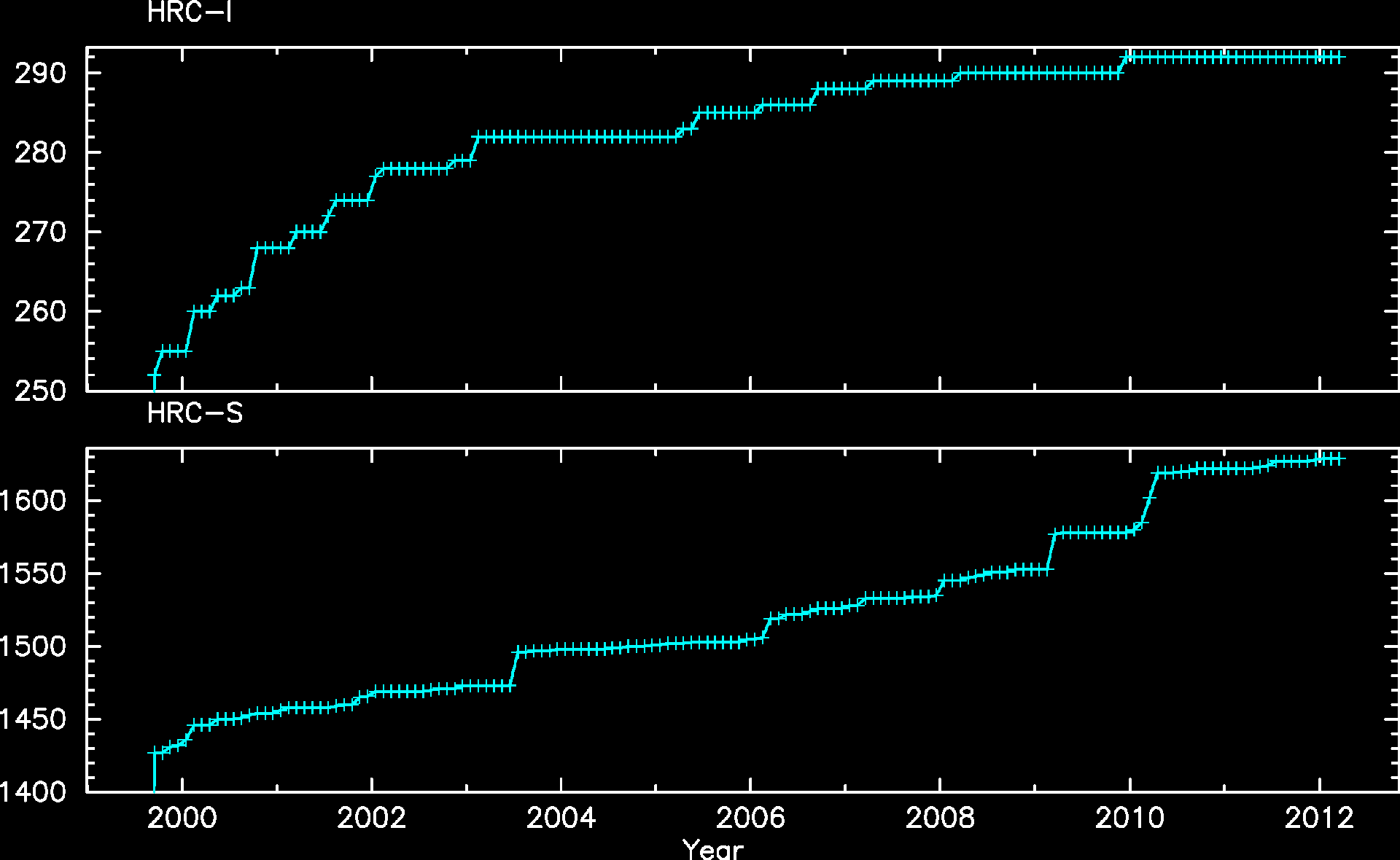
|
|
Max dose trend plots corrected for events that "pile-up"
in the center of the taps due to bad position information.
|
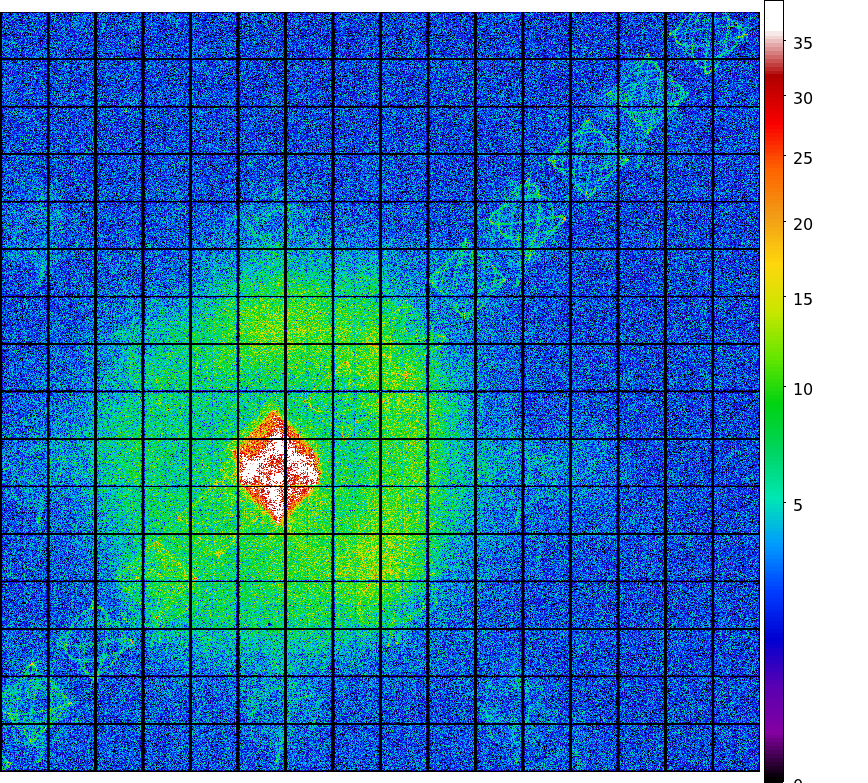
|

|

|

|
| Jan 2012 | Oct 2011 | Jul 2011 | Apr 2011 |
|---|

|

|

|
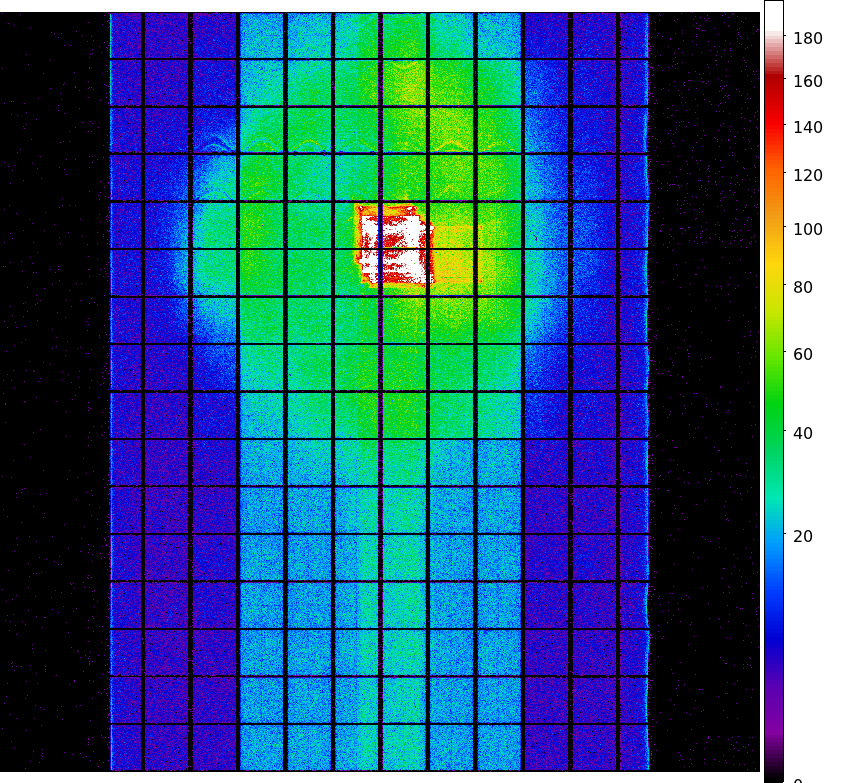
|
| Jan 2012 | Oct 2011 | Jul 2011 | Apr 2011 |
|---|
Gratings
Focus
We plot the width of the zero order streak of ACIS/HETG observations and the width of the zero order image for HRC/LETG observations of point sources. No significant defocusing trend is seen at this time. See Gratings Focus pages.

Gratings Resolving Power
We plot E/dE vs. E for fits to detected lines with fwhm_error/fwhm less than 0.15 for the plus and minus arms of HEG, MEG, and LEG. Also shown are conservative (dotted line) and optimistic (dashed line) pre-launch resolving power expectations.
We have selected only calibration observations of Capella, HR1099, and Sigma Gem. See MIT technotes for a parallel analysis.
| Plot symbol indicates dispersion arm: | Color indicates observation date: |
Minus side = cross (x) |
A002-2004 blue 2005-2006 yellow 2007-2009 orange |



PCAD
ACA Trending
Gyro Bias Drift

Radiation History
Radiation Zone Timing
Plotted below are radiation zone timing plots based on the following definitions of radiation zone:
- RADZONE - Ephin levels (in any of the E1300,P4GM,P41GM channels) are more than 1/3 of RADMON safing thresholds.
- RADMON - Radmon is disabled for radiation zone (as commanded based on OFLS model, for comparison with actual radiation levels).
- PERIGEE - Time of closest earth approach (for comparison)

Radiation Count Rates of Apr 2012

Sun Spot History
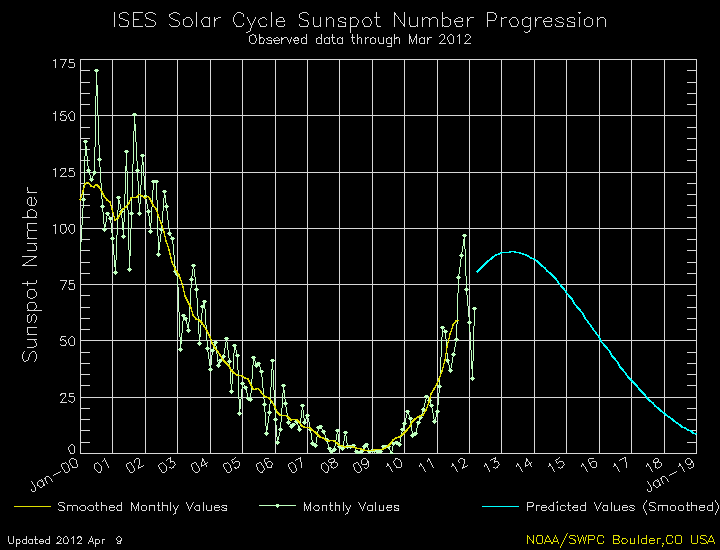
SIM
SIM Shift and Twist
SIM Shift and Twist Trend The following plots show trends of SIM shifts (dy and dz) and twist (dtheta). All quantities are directly taken from pcaf*_asol1.fits files. The units are mm for dy and dz, and degree for dtheta. We fit three lines separated before and after (Days of Mission)= 1400 (May 21, 2003), and 2700 (Dec 11, 2006). The unit of slopes are mm per day or degree per day.
The sudden shift around DOM = 1400 and 2700 are due to fid light drift (see a memo by Aldcroft fiducial light drift). On the dtheta plot, two tracks are clearly observed. The track around 0.01 is due to HRC-I, and all others are clustered around -0.002. For more detail, please see SIM Shift and Twist Trend page

Trending
Quarterly Trends
- Ephin Electronics and Temperture
| Previous Quarter | ||||||
| MSID | MEAN | RMS | DELTA/YR | DELTA/YR/YR | UNITS | DESCRIPTION |
| 5EPHINT | 321.87 | 4.23 | -5.965e+00 | -4.568e+02 | K | EPHIN TEMP |
| HKEBOXTEMP | 326.62 | 4.32 | -8.264e+00 | -5.012e+02 | K | EPHIN HOUSEKEEPING EBOX: TEMPERATURE (5EHSE300) |
| TEIO | 319.65 | 18.44 | -5.014e+01 | -1.609e+03 | K | EPHIN ELECTRONICS HOUSING TEMP |
| TEPHIN | 321.99 | 4.40 | -1.027e+01 | -5.284e+02 | K | EPHIN SENSOR HOUSING TEMP |
- SIM Temperture
| Previous Quarter | ||||||
| MSID | MEAN | RMS | DELTA/YR | DELTA/YR/YR | UNITS | DESCRIPTION |
| 3TSMXSPT | 270.02 | 29.10 | 7.891e+01 | 1.389e-11 | K | -X TURTLE SHELL NR ACIS SS |
| PSUTEMP | 311.67 | 0.83 | -7.696e-01 | 1.367e-13 | (3FAPSAT) | SEA power supply temperature |
| TSCMTRTEMP | 273.30 | 22.69 | -8.742e+01 | 4.023e-11 | K | TSC motor temperature |
- Spacecraft Anc Temperture
| Previous Quarter | ||||||
| MSID | MEAN | RMS | DELTA/YR | DELTA/YR/YR | UNITS | DESCRIPTION |
| TBOLTCUT | 243.33 | 21.81 | -1.152e+02 | -1.710e+03 | K | DOOR BOLT-CUTTER TEMP |
| TMYHNG | 216.07 | 11.21 | -5.549e+01 | -1.147e+03 | K | SUNSHADE DOOR HINGE BEAM TEMP (-Y SIDE) |
| TSCIUSF5 | 254.02 | 18.82 | -1.005e+02 | -1.570e+03 | K | SC-IUS FITTING-5 TEMP |
Spacecraft Motions

|

|

Reaction Wheel Rotations

Note: From Feb 2010, the computation of reaction wheel rotations are slightly modified.
Links to Past Monthly Reports
| Year | Month | |||||||||||
|---|---|---|---|---|---|---|---|---|---|---|---|---|
| 1999 | Jul | Aug | Sep | Oct | Nov | Dec | ||||||
| 2000 | Jan | Feb | Mar | Apr | May | Jun | Jul | Aug | Sep | Oct | Nov | Dec |
| 2001 | Jan | Feb | Mar | Apr | May | Jun | Jul | Aug | Sep | Oct | Nov | Dec |
| 2002 | Jan | Feb | Mar | Apr | May | Jun | Jul | Aug | Sep | Oct | Nov | Dec |
| 2003 | Jan | Feb | Mar | Apr | May | Jun | Jul | Aug | Sep | Oct | Nov | Dec |
| 2004 | Jan | Feb | Mar | Apr | May | Jun | Jul | Aug | Sep | Oct | Nov | Dec |
| 2005 | Jan | Feb | Mar | Apr | May | Jun | Jul | Aug | Sep | Oct | Nov | Dec |
| 2006 | Jan | Feb | Mar | Apr | May | Jun | Jul | Aug | Sep | Oct | Nov | Dec |
| 2007 | Jan | Feb | Mar | Apr | May | Jun | Jul | Aug | Sep | Oct | Nov | Dec |
| 2008 | Jan | Feb | Mar | Apr | May | Jun | Jul | Aug | Sep | Oct | Nov | Dec |
| 2009 | Jan | Feb | Mar | Apr | May | Jun | Jul | Aug | Sep | Oct | Nov | Dec |
| 2010 | Jan | Feb | Mar | Apr | May | Jun | Jul | Aug | Sep | Oct | Nov | Dec |
| 2011 | Jan | Feb | Mar | Apr | May | Jun | Jul | Aug | Sep | Oct | Nov | Dec |
| 2012 | Jan | Feb | Mar | |||||||||




